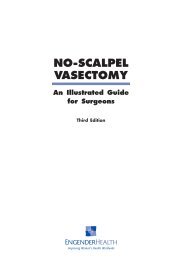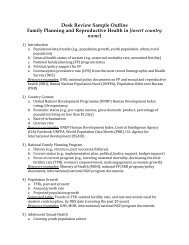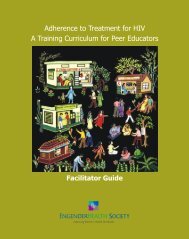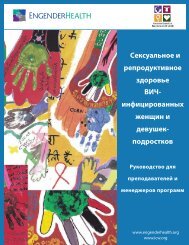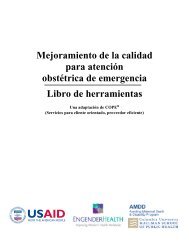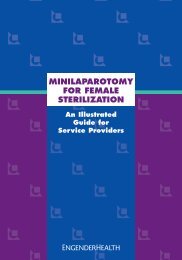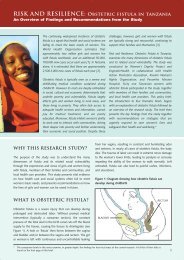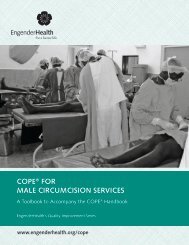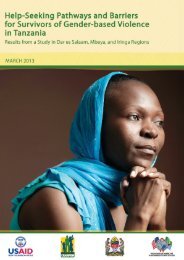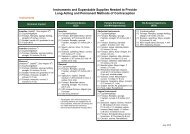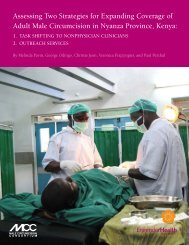Risk and Resilience: Obstetric Fistula in Tanzania - EngenderHealth
Risk and Resilience: Obstetric Fistula in Tanzania - EngenderHealth
Risk and Resilience: Obstetric Fistula in Tanzania - EngenderHealth
You also want an ePaper? Increase the reach of your titles
YUMPU automatically turns print PDFs into web optimized ePapers that Google loves.
of her community br<strong>in</strong>g her fuel wood, water, <strong>and</strong><br />
various gifts, <strong>and</strong> that they also wished her well so<br />
that she would get treatment <strong>and</strong> come back<br />
home safely. Another woman reported that her<br />
relationship with community members is good:<br />
They care for her <strong>and</strong> provide her with casual jobs<br />
so she can get money for daily needs.<br />
Fewer than half of the women specifically mentioned<br />
not go<strong>in</strong>g to religious gather<strong>in</strong>gs. As one woman<br />
expla<strong>in</strong>ed, “I was also disturbed because I couldn’t go<br />
anywhere. I just stayed <strong>in</strong>side <strong>and</strong> couldn’t even go to<br />
church.” (Woman from Ukerewe, age 21) One<br />
woman from S<strong>in</strong>gida attended religious gather<strong>in</strong>gs,<br />
but she said, “I go to church with friends <strong>and</strong> they<br />
know, but I have to leave before mass ends.” (Woman<br />
from S<strong>in</strong>gida, age 54)<br />
“I was also disturbed<br />
because I couldn’t go<br />
anywhere. I just stayed<br />
<strong>in</strong>side <strong>and</strong> couldn’t<br />
even go to church.”<br />
(Woman from Ukerewe, age 21)<br />
A m<strong>in</strong>ority of the women <strong>in</strong>terviewed said that the<br />
community did not know about their condition.<br />
One woman felt that this was the reason she got<br />
along well with her neighbors. One woman said<br />
that the only people that knew of her fistula were<br />
two of her children (daughters), despite the fact<br />
that she had lived with fistula for eight years.<br />
Other than shame, women also reported other<br />
social <strong>and</strong> emotional impacts result<strong>in</strong>g from fistula.<br />
Fewer than half of the women reported a negative<br />
impact on their stress level due to “liv<strong>in</strong>g with<br />
worries.” Additional stress came from spiritual<br />
repercussions (due to their <strong>in</strong>ability to attend church<br />
<strong>and</strong>/or mosque) <strong>and</strong> the <strong>in</strong>ability to have a child or<br />
to marry aga<strong>in</strong>. Two girls mentioned their <strong>in</strong>ability<br />
to return to school, <strong>and</strong> two reported the need to<br />
eat separately from others. A woman expla<strong>in</strong>ed:<br />
“Th<strong>in</strong>gs are upside down because of the ur<strong>in</strong>e<br />
problem, <strong>and</strong> I don’t have a s<strong>in</strong>gle child. What k<strong>in</strong>d<br />
of life is this” (Woman from Songea, age 30)<br />
Views of Family <strong>and</strong> Community Members<br />
Family members described how they perceived<br />
fistula’s impact. The majority mentioned that<br />
women experienced isolation, ma<strong>in</strong>ly as a result of<br />
shame (fear of leak<strong>in</strong>g <strong>in</strong> front of people or of<br />
smell<strong>in</strong>g), of fear of harassment/ridicule, or of<br />
weakness due to their compromised ability to<br />
walk. A few family members also <strong>in</strong>dicated that<br />
fistula had an impact on the spiritual lives of the<br />
women because of their <strong>in</strong>ability to attend church<br />
<strong>and</strong>/or mosque. A m<strong>in</strong>ority of family members<br />
explicitly mentioned the sadness of liv<strong>in</strong>g with<br />
fistula. For example, one set of parents reported<br />
that their daughter experienced sadness <strong>and</strong><br />
lonel<strong>in</strong>ess, <strong>and</strong> another set mentioned that their<br />
daughter was always unhappy because she could<br />
not walk properly <strong>and</strong> could not visit relatives or<br />
friends because of shame.<br />
Community members were also asked their<br />
perception of the impact of fistula on girls <strong>and</strong><br />
women liv<strong>in</strong>g with the condition. They mentioned<br />
lonel<strong>in</strong>ess, shame, <strong>and</strong> isolation after fistula, as well<br />
as the fact that <strong>in</strong> some cases, women with fistula<br />
are discrim<strong>in</strong>ated aga<strong>in</strong>st by their family <strong>and</strong> friends.<br />
Health care providers also mentioned isolation,<br />
shame, <strong>and</strong> lonel<strong>in</strong>ess as a result of fistula.<br />
Health Impact<br />
Fewer than half of the women <strong>in</strong>terviewed<br />
specifically mentioned health-related impacts of<br />
fistula. Of these, around half mentioned that their<br />
health had changed or that they felt sick or had<br />
pa<strong>in</strong>. Fewer than half mentioned hav<strong>in</strong>g sores<br />
around their genitals as a result of fistula. Other<br />
responses mentioned <strong>in</strong>cluded foot drop, 19 feel<strong>in</strong>g<br />
a lack of energy, experienc<strong>in</strong>g weakness, or tir<strong>in</strong>g<br />
easily. The majority of women had access to health<br />
care services after susta<strong>in</strong><strong>in</strong>g a fistula. A m<strong>in</strong>ority,<br />
however, <strong>in</strong>dicated that they had access to services<br />
but could not use them because of lack of <strong>in</strong>come.<br />
Two mentioned not us<strong>in</strong>g health care services<br />
because of shame or because then their problem<br />
would be revealed.<br />
19 “Foot drop” is a weakness of the muscles that are <strong>in</strong>volved <strong>in</strong> flex<strong>in</strong>g the ankle <strong>and</strong> toes, which may be caused by the pressure<br />
of the baby’s head on the nerves of a woman’s legs dur<strong>in</strong>g labor. As a result, the toes droop downward <strong>and</strong> impede the normal<br />
walk<strong>in</strong>g motion.<br />
28



